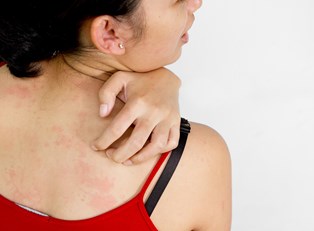Rosacea is a chronic inflammatory disease of the skin that causes redness, flushing, and visible blood vessels in the central area of the face. Sometimes it is mistaken for adult acne because rosacea also tends to cause red bumps that are sometimes filled with puss on the cheeks and nose. Rosacea can also affect the eyes and the surrounding tissue, causing dryness, redness, and itchiness.
Understanding Flare-Ups
Experts believe rosacea can be genetically inherited because it tends to run in families, but the cause is still unknown. No cure is yet available, so your dermatologist will focus on controlling your symptoms during outbreaks and helping you pinpoint what your triggers are.
A number of factors are thought to trigger rosacea flare-ups, and they vary greatly among patients. Rosacea is non-contagious and anyone can have it, but it most commonly occurs in fair-skinned women between the ages of 30 and 50. Men often suffer from rosacea’s damaging effects because they delay seeking treatment. Although rosacea is not life-threatening, coping with this disease can greatly impact psychosocial aspects of life, especially self-esteem.
Symptoms
According to the National Rosacea Society, rosacea has been categorized into subtypes due to the broad scope of symptoms patients experience. A patient may have only one subtype or experience a combination of several simultaneously.
- Subtype 1: Facial redness
Erythematotelengiectatic rosacea (ETR) is often the first type of rosacea patients experience. Symptoms vary from patient to patient but may include persistent redness of the cheeks and nose, flushing, blushing, and visible blood vessels. The skin may also be dry, flaky, itchy, and may burn when skincare products are applied or when exposed to heat or weather elements. ETR is often treated with a topical gel or cream.
- Subtype 2: Bumps and pimples
Papulopustular rosacea is the type which is sometimes mistaken for acne. Unlike rosacea, acne usually affects the lower regions of the face and includes the presence of whiteheads and blackheads. Eczema, also characterized by redness, differs from rosacea because it produces more of a blister-type sore rather than an inflamed bump or pustule (puss-filled bump).
- Subtype 3: Skin thickening and disfiguration
Phymatous rosacea occurs in more men than women, and it is considered to be the most severe form of the disease. A condition called rhynophyma is associated with this type of rosacea and is characterized by the enlargement or disfiguration of the nose. Rhynophyma, sometimes called “bulbous nose,” is usually treated surgically by cutting away the excess growth of tissue.
- Subtype 4: Eye irritation
Ocular rosacea occurs in nearly half of all patients with skin rosacea, according to the Mayo Clinic. Symptoms include dry or watery eyes, styes around the eye, and a grainy sensation. The eyes may appear bloodshot with noticeable blood vessels on the surface. Eyelids may burn or itch, and patients may have sensitivity to light. Like other forms of rosacea, this subtype has no cure and no prevention measures are available. When left untreated, permanent damage to the cornea may occur, impacting vision. Treatment includes avoiding flare-ups by learning triggers and controlling symptoms with oral drug therapy and prescription eye drops.



